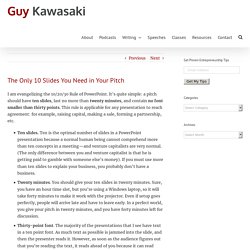

Lessons From A Study of Perfect Pitch Decks: VCs Spend An Average of 3 Minutes, 44 Seconds On Them. DocSend, a startup that provides people with a secure and private way of sharing files like offer letters or legal agreements, studied more than 200 pitchdecks to figure out the right way to graduate from bootstrapped to seed-funded, or from angels to a Series A.

They partnered with Harvard Business School professor Tom Eisenmann to look at companies that had raised $360 million in total. What did they find? You can see the whole study here. Anyway, they discovered that companies needed an average of 40 investor meetings and took a little over 12 weeks to close a round. Investors don’t look at pitch decks for very long — just an average of 3 minutes and 44 seconds.
There wasn’t really any correlation between more meetings and more funding. It’s better to go find firms that are already aligned with what your company does and target them first. Then, seed funds can move faster and provide more money than angels. Don’t Let Your Investors Buy All The Options. One of the most pronounced misalignments between investors and entrepreneurs is around the concept of “optionality.”

I’m not talking about stock options, but the freedom to choose from a variety of different strategic and tactical options when running your startup. I learned, the hard way, that the founder has to create his/her own optionality or your startup is at the whim of your investors. The more shots on goal you have, the more likely you’ll be successful. Paradoxically, more funding means fewer shots, and less optionality for you. When you first start the company founders have ultimate optionality. As a former startup founder I noticed that as my companies raised multiple rounds of funding the investors gained options, while mine narrowed. For example, if you’re fortunate enough to take $20 million in venture capital at a $100 million valuation, you can no longer sell the company for $80 million even if it’s a windfall for management. Running Out of Options Managing the burn. GoodUI.
Email Patterns for Web Apps — The Right Tool For the Right Job. 2.

Personal Welcome Email from Founder Another common pattern is to send a secondary welcome email from the Founder. This email is usually sent a few hours later or the next day. I have tried this in the past and it was so successful that it started taking me hours every day to reply to every user who wrote back. So, I had to disable it. 3. I don’t think I have seen this pattern somewhere else before. 4. I was very impressed with the tutorials Loggly sent when we signed up. Emails contain high quality tutorials about various topics on Loggly. 5. If you constantly have fresh content, sending a digest email is a great way to get them to re-engage with your product. 6. In a similar fashion, content sites can send a list of most popular content for the previous week/month. The Only 10 Slides You Need in Your Pitch.
I am evangelizing the 10/20/30 Rule of PowerPoint.

It’s quite simple: a pitch should have ten slides, last no more than twenty minutes, and contain no font smaller than thirty points. This rule is applicable for any presentation to reach agreement: for example, raising capital, making a sale, forming a partnership, etc. Ten slides. Ten is the optimal number of slides in a PowerPoint presentation because a normal human being cannot comprehend more than ten concepts in a meeting—and venture capitalists are very normal. (The only difference between you and venture capitalist is that he is getting paid to gamble with someone else’s money). The infographic created in collaboration with my friends at Visually will help you fine tune what to put on your ten slides.
From Visually. Tap to Expand Embed the above image on your site Customize size Click to copy Share This Story, Choose Your Platform! Guy Kawasaki is the chief evangelist of Canva, an online graphic design tool. Related Posts. The Ultimate Growth Hacking Sourcebook /// Tiger Tiger.